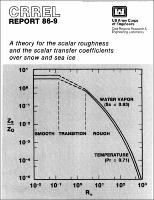Please use this identifier to cite or link to this item:
https://hdl.handle.net/11681/9435| Title: | A theory for the scalar roughness and the scalar transfer coefficients over snow and sea ice |
| Authors: | Andreas, Edgar L. |
| Keywords: | Heat and moisture exchange Surface processes Roughness lengths Turbulence Sea ice Snow |
| Publisher: | Cold Regions Research and Engineering Laboratory (U.S.) Engineer Research and Development Center (U.S.) |
| Series/Report no.: | CRREL report ; 86-9. |
| Description: | CRREL Report Abstract: The bulk aerodynamic transfer coefficients for sensible (𝘾𝗛) and latent (𝘾𝗘) heat over snow and sea ice surfaces are necessary for accurately modeling the surface energy budget but are very difficult to measure. This report therefore presents a theory that predicts 𝘾𝗛 and 𝘾𝗘 as functions of the wind speed and a surface roughness parameter. The crux of the model is establishing the interfacial sublayer profiles of the scalars, temperature and water vapor, over aerodynamically smooth and rough surfaces. These interfacial sublayer profiles are derived from a surface-renewal model in which turbulent eddies continually sweep, down to the surface, transfer scalar contaminants across the interface by molecular diffusion, and then burst away. Matching the interfacial sublayer profiles with the usual semilogarithmic inertial sublayer profiles yields the roughness lengths for temperature and water vapor. With these and a model for the drag coefficient over snow and sea ice based on actual measurements, the transfer coefficients are predicted. 𝘾𝗘 is always a few percent larger than 𝘾𝗛. Both decrease monotonically with increasing wind speed for speeds above 1 m/s, and both increase at all wind speeds as the surface gets rougher. Both, nevertheless, are almost always between 1.0x10^-3 and 1.5x10^-3. |
| Rights: | Approved for public release; distribution is unlimited. |
| URI: | http://hdl.handle.net/11681/9435 |
| Appears in Collections: | CRREL Report |
Files in This Item:
| File | Description | Size | Format | |
|---|---|---|---|---|
| CR-86-9.pdf | 1 MB | Adobe PDF |  View/Open |